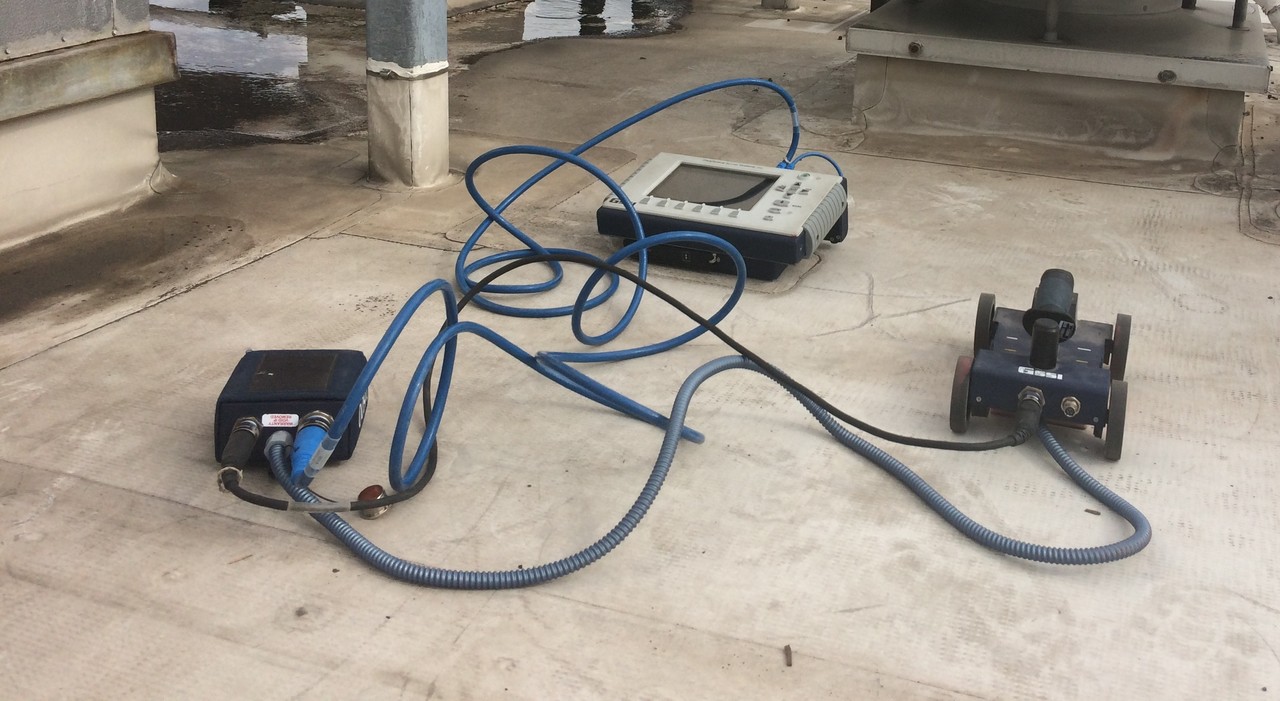Whether for embedded utility detecting or non-destructive testing (NDT) of concrete slabs, ground penetrating radar (GPR) interpretation involving rebar is often unavoidable. Understanding how GPR waves travel in reinforced concrete, and consequently what corresponding GPR profiles look like, are very important for appropriate GPR data interpretation.
This article is about a "ghost rebar" phenomenon often encountered during GPR scanning of concrete slabs. These ghost rebar are not real but can show up and look real in GPR profiles. Even in theory this phenomenon can be easily understood, ghost rebar can cause confusion for data interpretation in real situations, especially when the concrete is not homogeneous or there are complex rebar patterns.
Let's take a look at a GPR profile as shown below before and after data processing. It's collected on a concrete floor with a basement underneath.

FIG. 1a. Raw GPR data.

FIG. 1b. Processed GPR data.
In the profile, there are two sets of hyperbolas involving rebar. The processed data give a better view of them. It seems there are two layers of rebar, but actually only the top ones are real. The bottom hyperbolas are caused by diffraction from the real rebar and then reflected from the concrete bottom. Here I refer them as ghost rebar. So you need a real rebar with a highly reflective interface below it (such as concrete/air interface at the bottom of a concrete slab) to see its corresponding ghost rebar; and the ghost rebar (the hyperbola peak) is always very close to that interface no matter whether the real rebar is close to that interface or not. In the middle section of the profile, there are no reflection bottoms due to thick concrete there, hence there are no ghost rebar. If you scan on-grade reinforced concrete floor and there are voids underneath, you might also see the ghost rebar together with the highly reflective concrete bottom. Also, if there are multiple layers of concrete, you might see multiple layers of ghost rebar. Sometimes you probably would miss the interface with relative weak reflections if not for the signatures of ghost rebar -- hyperbolas can be spotted more easily than horizontal layers in GPR profiles, especially in unprocessed data.
A GPR data simulation is done and its profile is shown below. There are 5 rebar at different depths and each one of them has a corresponding ghost rebar at the concrete bottom.

FIG. 2. A GPR data simulation showing signatures of rebar and their corresponding ghost rebar.
Ghost rebar is usually something we don't like to see when looking for embedded utilities such as electrical conduits. When you have multiple layers of rebar and/or multiple layers of concrete, it's already difficult to see embedded utilities; ghost rebar just make it worse. Below is a simulated GPR profile, can you see some real objects close to the concrete bottom?

FIG. 3a. A GPR data simulation with multiple layers of rebar/conduits.
The model of the simulation is shown below with the simulated data. The red circles are real objects which could be either rebar or conduits. Most of them have diameters around 1 inch. How many of them did you miss before you see the model? Or did you think something is real but actually it's not? Some difficult-to-see objects (OB1 to OB6) close to the concrete bottom are noted. OB1, OB5 and OB6 are especially easy to miss since there are double layers of real objects above them. They are difficult to see due to ghost objects caused by real objects above. Remember in real situations the concrete is usually not this homogeneous as in the model, and consequently the shapes and colors of hyperbolas are not necessarily representing relative sizes of the objects. The main problem is that the tails of hyperbolas from real and ghost objects mix together around and below the concrete bottom, making it hard to tell whether there are real objects close to the concrete bottom.

FIG. 3b. A GPR model and its data simulation with multiple layers of rebar/conduits.
To alleviate the problem in real situations, you can try data processing techniques (such as migration, etc), 3D GPR mapping, expanding survey areas, tracing conducts using electromagnetic cable/pipe locators, just to name a few. But I like to point out that scanning from the concrete bottom is also a good option. We always say that compared to X-rays, we only need to access one side of the concrete floor using GPR; but it doesn't mean scanning from the concrete floor bottom doesn't provide valuable information, even when you can see the concrete bottom clearly from the scanning on top of the concrete floor.
Although ghost rebar is a problem for utility locating, it might be useful in NDT of concrete. Shape of hyperbolas and reflection amplitudes in rebar signatures have been used to characterize rebar and concrete. Maybe ghost rebar can also be used as an auxiliary way to evaluate reinforced concrete? One interesting question is, is the arrival time or amplitude difference between the concrete bottom reflection and the ghost rebar reflection related to the rebar size or condition? If so, can it be used to evaluate the rebar size or condition?
Ghost rebar near reflective interfaces is only one of the interesting phenomena frequently encountered in GPR concrete scanning involving rebar. Other phenomena include reflection multiples, signals bouncing between adjacent rebar, etc. Understanding and possibly utilizing them could greatly benefit GPR applications on concrete scanning.




